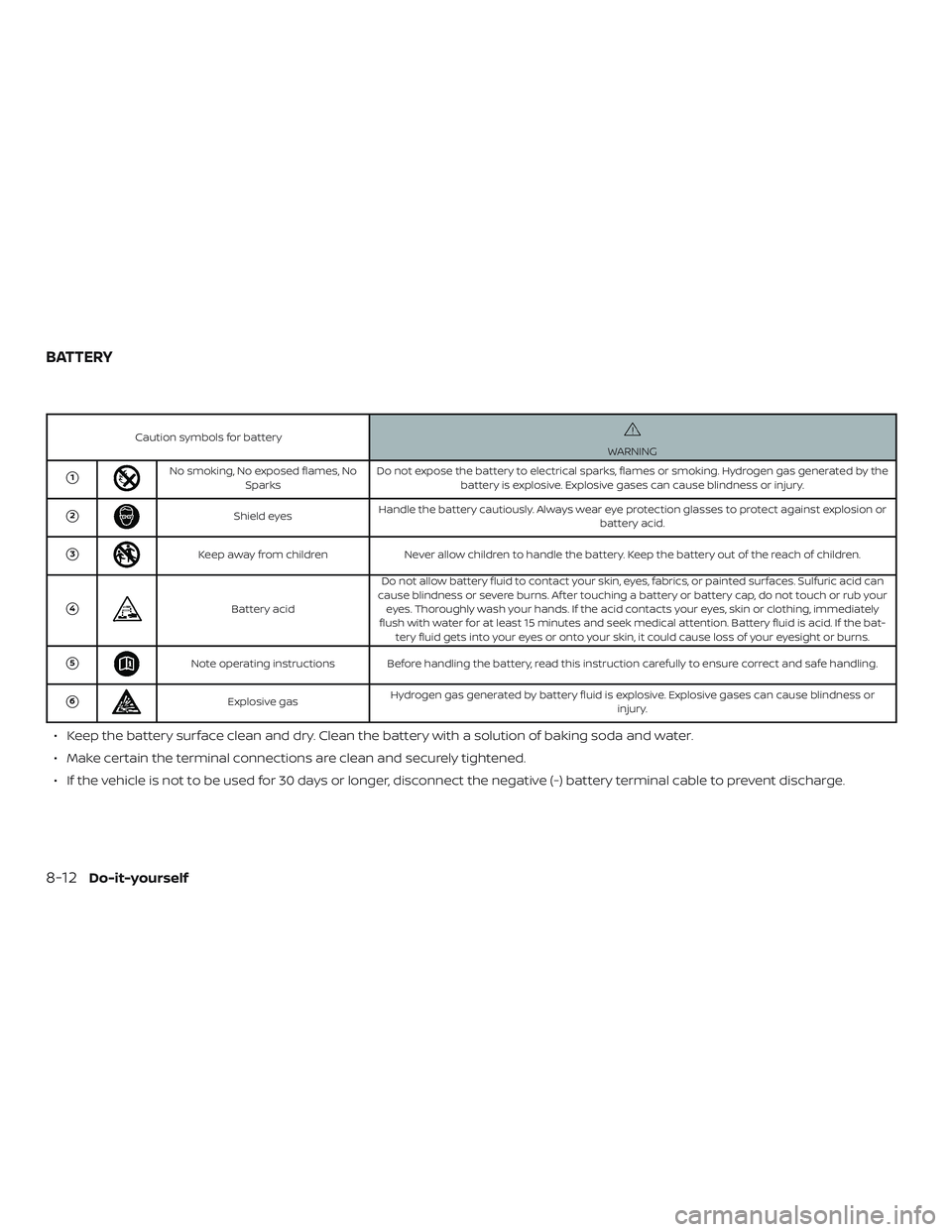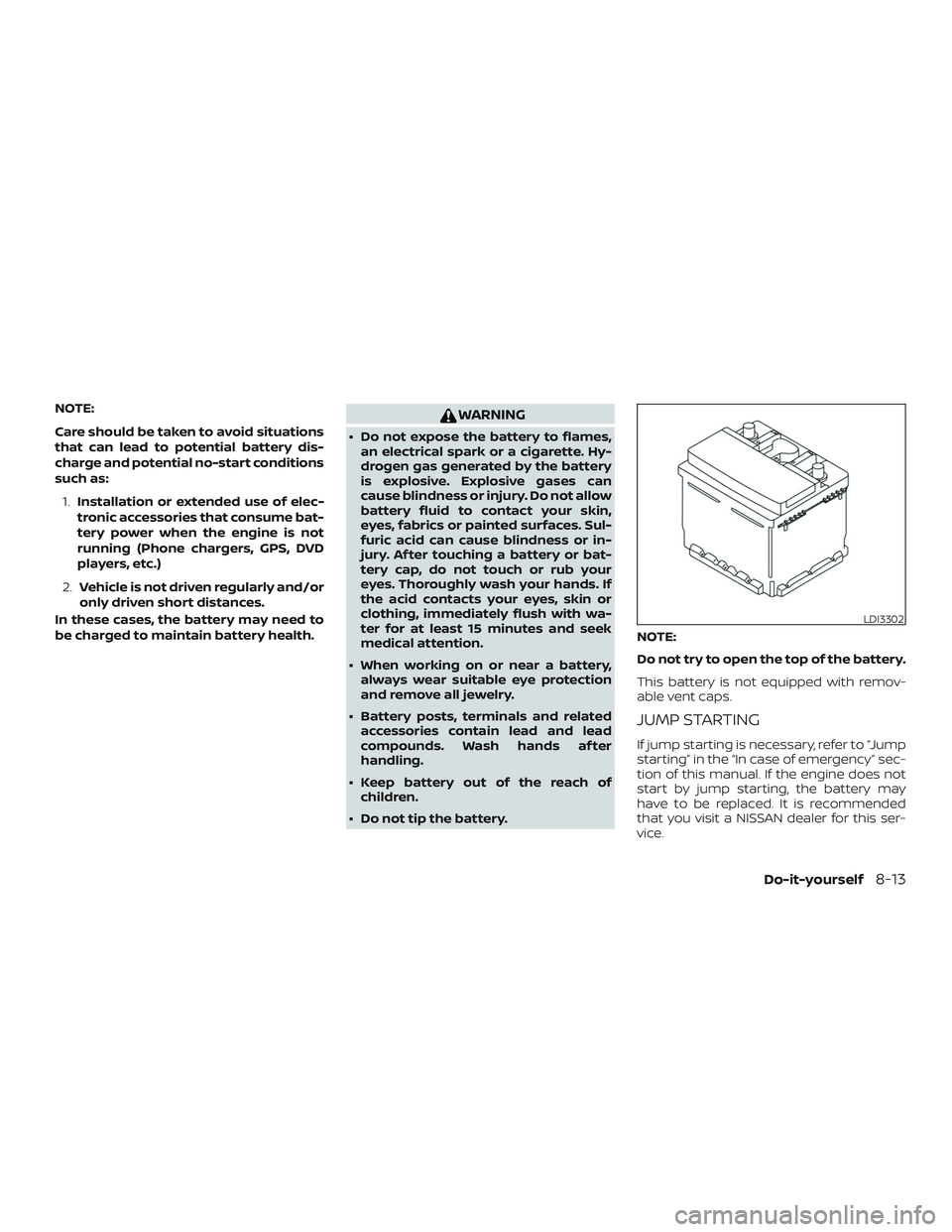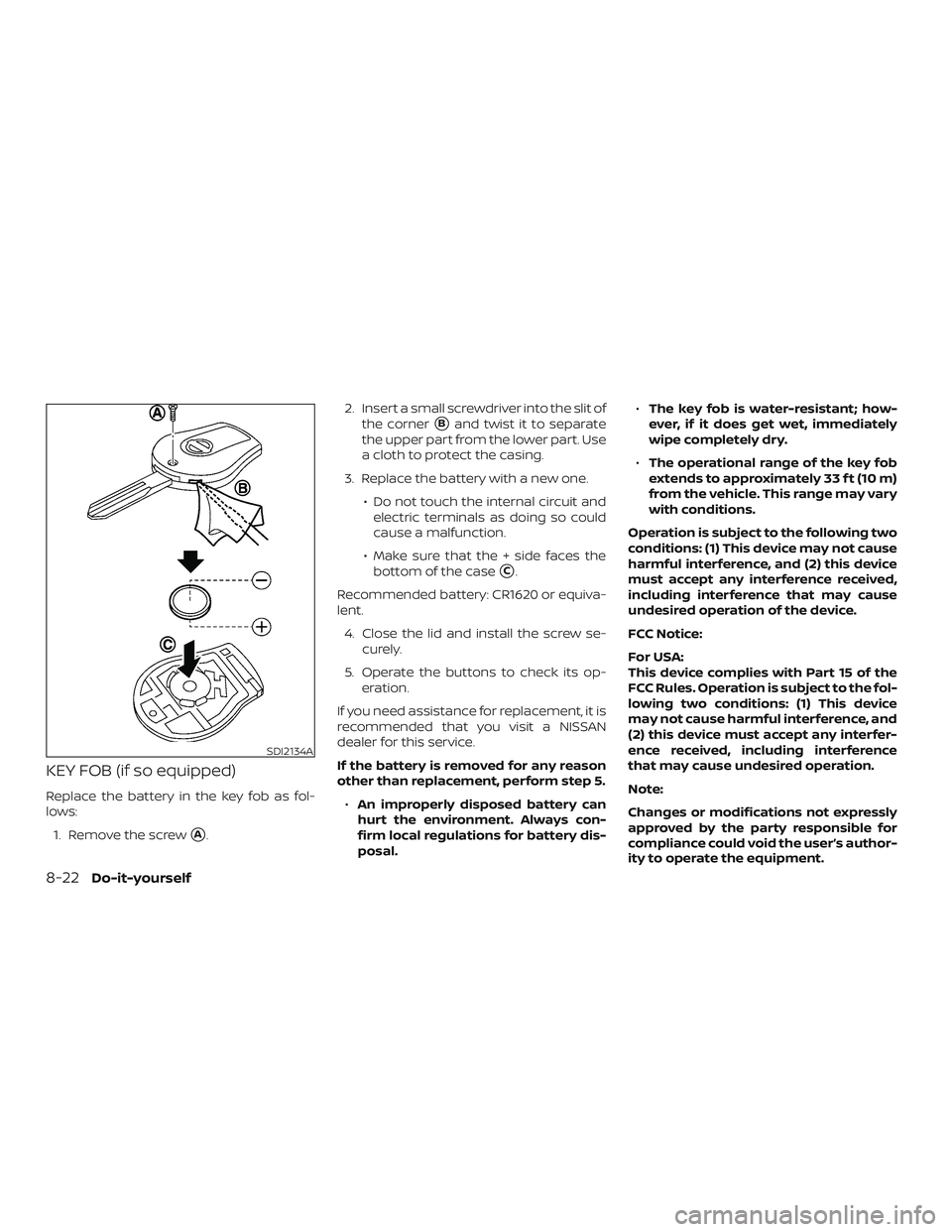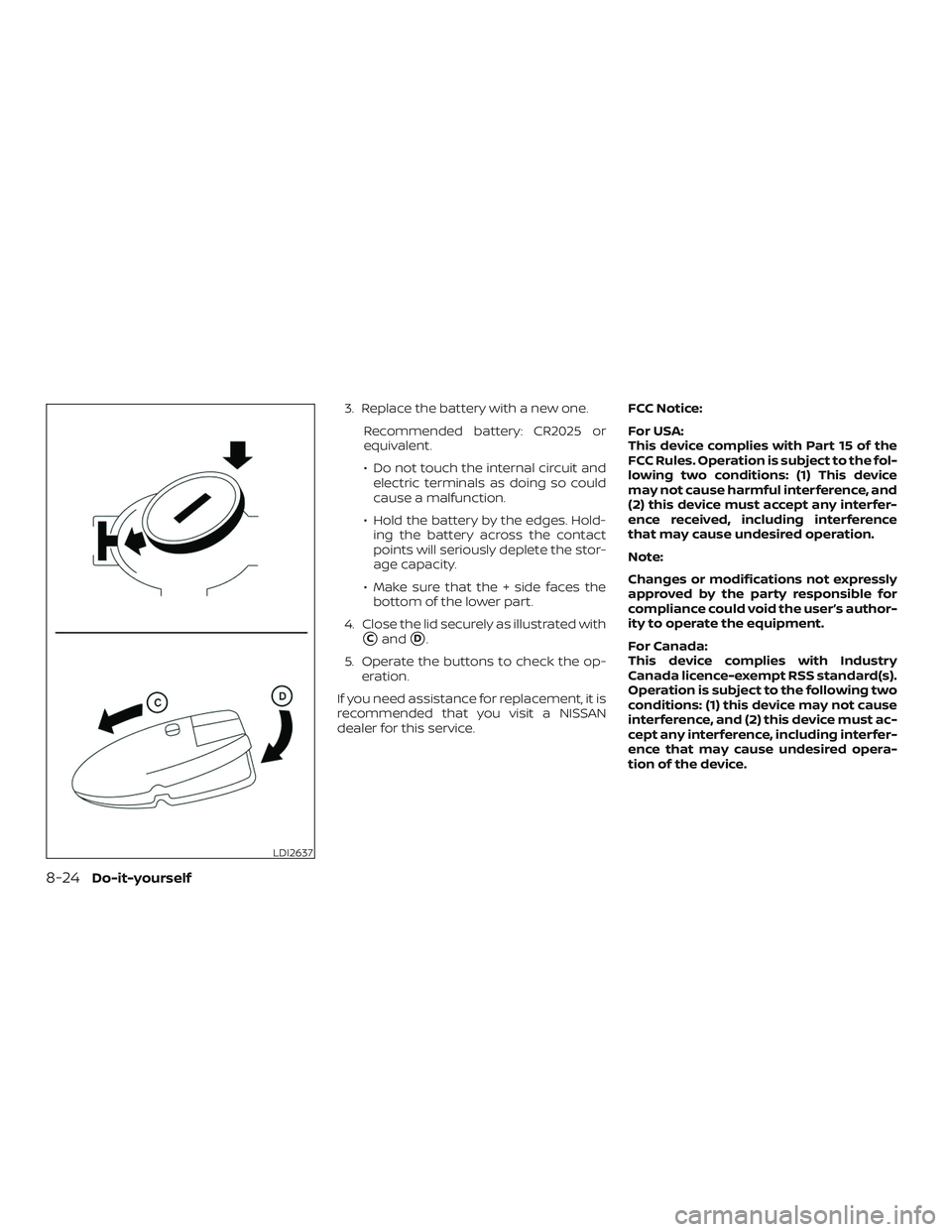Page 283 of 372
HR16DE engine
1. Drive belt location
2. Engine oil filler cap
3. Air cleaner
4. Brake and clutch (if so equipped)fluid reservoir
5. Fusible link
6. Battery
7. Engine coolant reservoir
8. Radiator cap
9. Engine oil dipstick
10. Windshield-washer fluid reservoir
LDI3231
ENGINE COMPARTMENT CHECK
LOCATIONS
Do-it-yourself8-3
Page 292 of 372

Caution symbols for batteryWARNING
�1No smoking, No exposed flames, NoSparks Do not expose the battery to electrical sparks, flames or smoking. Hydrogen gas generated by the
battery is explosive. Explosive gases can cause blindness or injury.
�2Shield eyes Handle the battery cautiously. Always wear eye protection glasses to protect against explosion or
battery acid.
�3Keep away from childrenNever allow children to handle the battery. Keep the battery out of the reach of children.
�4Battery acidDo not allow battery fluid to contact your skin, eyes, fabrics, or painted surfaces. Sulfuric acid can
cause blindness or severe burns. Af ter touching a battery or battery cap, do not touch or rub your eyes. Thoroughly wash your hands. If the acid contacts your eyes, skin or clothing, immediately
flush with water for at least 15 minutes and seek medical attention. Battery fluid is acid. If the bat- tery fluid gets into your eyes or onto your skin, it could cause loss of your eyesight or burns.
�5Note operating instructions Before handling the battery, read this instruction carefully to ensure correct and safe handling.
�6Explosive gas Hydrogen gas generated by battery fluid is explosive. Explosive gases can cause blindness or
injury.
∙ Keep the battery surface clean and dry. Clean the battery with a solution of baking soda and water.
∙ Make certain the terminal connections are clean and securely tightened.
∙ If the vehicle is not to be used for 30 days or longer, disconnect the negative (-) battery terminal cable to prevent discharge.
BATTERY
8-12Do-it-yourself
Page 293 of 372

NOTE:
Care should be taken to avoid situations
that can lead to potential battery dis-
charge and potential no-start conditions
such as:1. Installation or extended use of elec-
tronic accessories that consume bat-
tery power when the engine is not
running (Phone chargers, GPS, DVD
players, etc.)
2. Vehicle is not driven regularly and/or
only driven short distances.
In these cases, the battery may need to
be charged to maintain battery health.WARNING
∙ Do not expose the battery to flames, an electrical spark or a cigarette. Hy-
drogen gas generated by the battery
is explosive. Explosive gases can
cause blindness or injury. Do not allow
battery fluid to contact your skin,
eyes, fabrics or painted surfaces. Sul-
furic acid can cause blindness or in-
jury. Af ter touching a battery or bat-
tery cap, do not touch or rub your
eyes. Thoroughly wash your hands. If
the acid contacts your eyes, skin or
clothing, immediately flush with wa-
ter for at least 15 minutes and seek
medical attention.
∙ When working on or near a battery, always wear suitable eye protection
and remove all jewelry.
∙ Battery posts, terminals and related accessories contain lead and lead
compounds. Wash hands af ter
handling.
∙ Keep battery out of the reach of children.
∙ Do not tip the battery. NOTE:
Do not try to open the top of the battery.
This battery is not equipped with remov-
able vent caps.
JUMP STARTING
If jump starting is necessary, refer to “Jump
starting” in the “In case of emergency” sec-
tion of this manual. If the engine does not
start by jump starting, the battery may
have to be replaced. It is recommended
that you visit a NISSAN dealer for this ser-
vice.
LDI3302
Do-it-yourself8-13
Page 294 of 372

CAUTION
∙ Do not ground accessories directly tothe battery terminal. Doing so will by-
pass the variable voltage control sys-
tem and the vehicle battery may not
charge completely.
∙ Use electrical accessories with the en- gine running to avoid discharging the
vehicle battery.
Your vehicle is equipped with a variable
voltage control system. This system mea-
sures the amount of electrical discharge
from the battery and controls voltage gen-
erated by the generator. The current sensor
�Ais located near the
battery along the negative battery cable. If
you add electrical accessories to your ve-
hicle, be sure to ground them to a suitable
body ground such as the frame or engine
block area.
1. Water pump pulley
2. Generator pulley
3. Manual tensioner pulley
4. Air conditioner compressor pulley
5. Crankshaf t pulley
WARNING
Be sure the ignition switch is placed in
the OFF or LOCK position before servic-
ing drive belt. The engine could rotate
unexpectedly.
LDI3286LDI2399
VARIABLE VOLTAGE CONTROL
SYSTEM (if so equipped) DRIVE BELT
8-14Do-it-yourself
Page 301 of 372
Extended storage switch
If any electrical equipment does not oper-
ate, remove the extended storage switch
and check for an open fuse.
NOTE:
The extended storage switch is used for
long term vehicle storage. Even if the ex-
tended storage switch is broken it is not
necessary to replace it. Replace only the
open fuse in the switch with a new fuse.
How to replace the extended storage
switch:1. To remove the extended storage
switch, be sure the ignition switch is in
the OFF or LOCK position.
2. Be sure the headlight switch is in the OFF position.
3. Remove the fuse box cover.
4. Pinch the locking tabs
�Aand�Bfound
on each side of the storage switch.
5. Pull the storage switch straight out from the fuse box
�C.
CAUTION
Be careful not to allow children to swal-
low the battery or removed parts.
LDI2747
BATTERY REPLACEMENT
Do-it-yourself8-21
Page 302 of 372

KEY FOB (if so equipped)
Replace the battery in the key fob as fol-
lows:1. Remove the screw
�A. 2. Insert a small screwdriver into the slit of
the corner
�Band twist it to separate
the upper part from the lower part. Use
a cloth to protect the casing.
3. Replace the battery with a new one. ∙ Do not touch the internal circuit andelectric terminals as doing so could
cause a malfunction.
∙ Make sure that the + side faces the bottom of the case
�C.
Recommended battery: CR1620 or equiva-
lent. 4. Close the lid and install the screw se- curely.
5. Operate the buttons to check its op- eration.
If you need assistance for replacement, it is
recommended that you visit a NISSAN
dealer for this service.
If the battery is removed for any reason
other than replacement, perform step 5. ∙ An improperly disposed battery can
hurt the environment. Always con-
firm local regulations for battery dis-
posal. ∙
The key fob is water-resistant; how-
ever, if it does get wet, immediately
wipe completely dry.
∙ The operational range of the key fob
extends to approximately 33 f t (10 m)
from the vehicle. This range may vary
with conditions.
Operation is subject to the following two
conditions: (1) This device may not cause
harmful interference, and (2) this device
must accept any interference received,
including interference that may cause
undesired operation of the device.
FCC Notice:
For USA:
This device complies with Part 15 of the
FCC Rules. Operation is subject to the fol-
lowing two conditions: (1) This device
may not cause harmful interference, and
(2) this device must accept any interfer-
ence received, including interference
that may cause undesired operation.
Note:
Changes or modifications not expressly
approved by the party responsible for
compliance could void the user’s author-
ity to operate the equipment.
SDI2134A
8-22Do-it-yourself
Page 303 of 372
For Canada:
This device complies with Industry
Canada licence-exempt RSS standard(s).
Operation is subject to the following two
conditions: (1) this device may not cause
interference, and (2) this device must ac-
cept any interference, including interfer-
ence that may cause undesired opera-
tion of the device.NISSAN INTELLIGENT KEY® (if so
equipped)
Replace the battery in the Intelligent Key as
follows:1. Remove the mechanical key from the Intelligent Key.
2. Insert a small flathead screwdriver
�A
into the slit�Bof the corner and twist it
to separate the upper part from the
lower part. Place a cloth over the
screwdriver to protect the casing.
LDI2001
Do-it-yourself8-23
Page 304 of 372

3. Replace the battery with a new one.Recommended battery: CR2025 or
equivalent.
∙ Do not touch the internal circuit andelectric terminals as doing so could
cause a malfunction.
∙ Hold the battery by the edges. Hold- ing the battery across the contact
points will seriously deplete the stor-
age capacity.
∙ Make sure that the + side faces the bottom of the lower part.
4. Close the lid securely as illustrated with
�Cand�D.
5. Operate the buttons to check the op- eration.
If you need assistance for replacement, it is
recommended that you visit a NISSAN
dealer for this service. FCC Notice:
For USA:
This device complies with Part 15 of the
FCC Rules. Operation is subject to the fol-
lowing two conditions: (1) This device
may not cause harmful interference, and
(2) this device must accept any interfer-
ence received, including interference
that may cause undesired operation.
Note:
Changes or modifications not expressly
approved by the party responsible for
compliance could void the user’s author-
ity to operate the equipment.
For Canada:
This device complies with Industry
Canada licence-exempt RSS standard(s).
Operation is subject to the following two
conditions: (1) this device may not cause
interference, and (2) this device must ac-
cept any interference, including interfer-
ence that may cause undesired opera-
tion of the device.
LDI2637
8-24Do-it-yourself